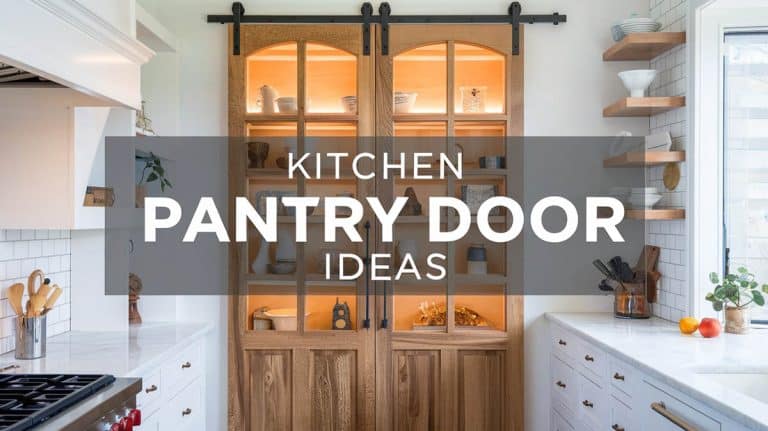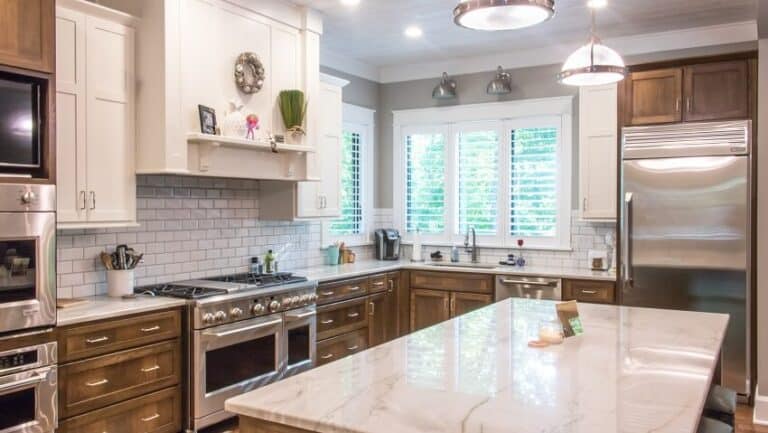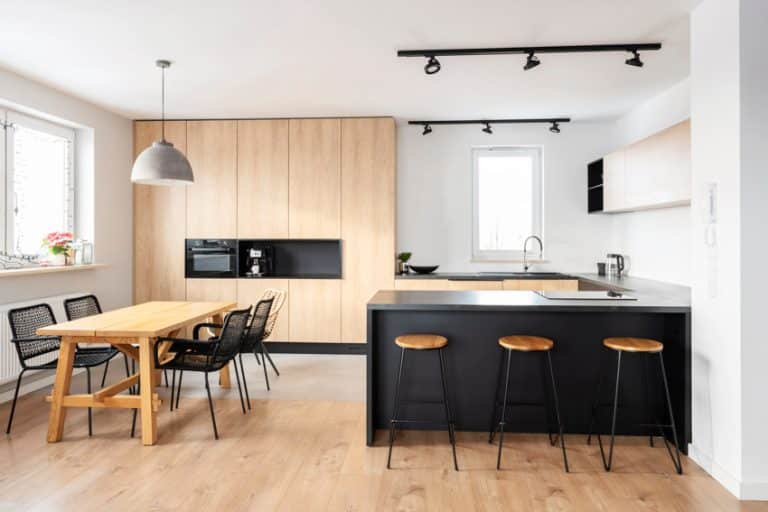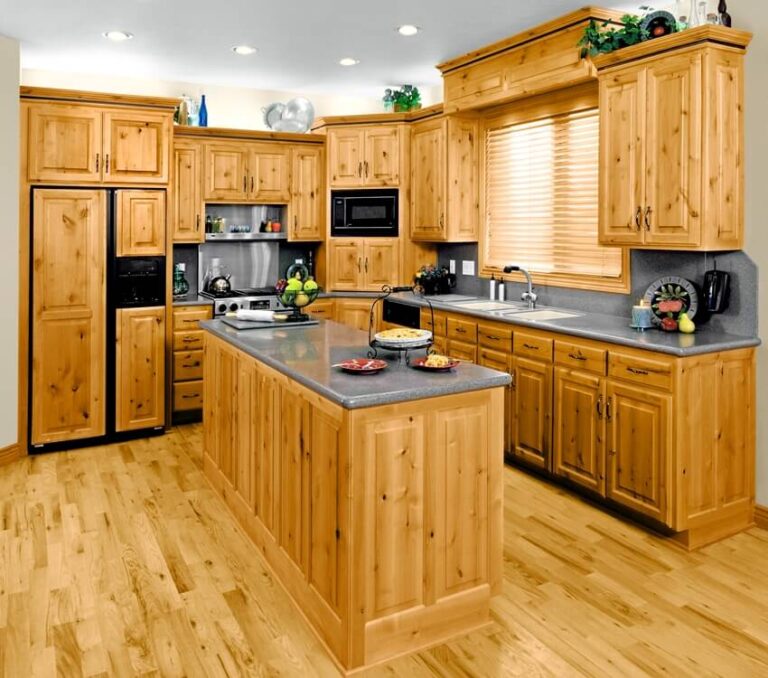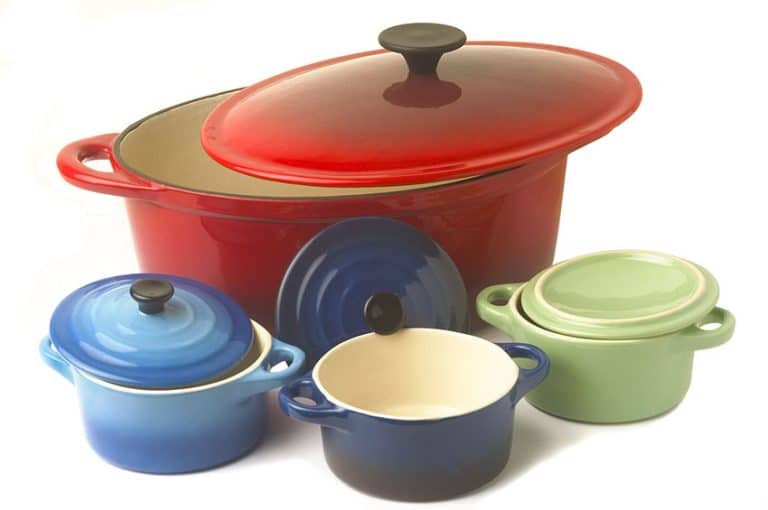Types Of Cutting Boards (Ultimate Buying Guide)
Here we share the different types of cutting boards guide including their uses and some essential details about their materials, size, shapes, and features.

When the innovation of tools to smoothly cut wood came to be, it paved the way for the popularity of cutting boards. At some point in your life, whether you’re a homeowner or not, you’re bound to own at least one cutting board in your life.
Read on to find out anything and everything you will ever need to know about cutting boards below.
Cutting Board Uses

Different Types
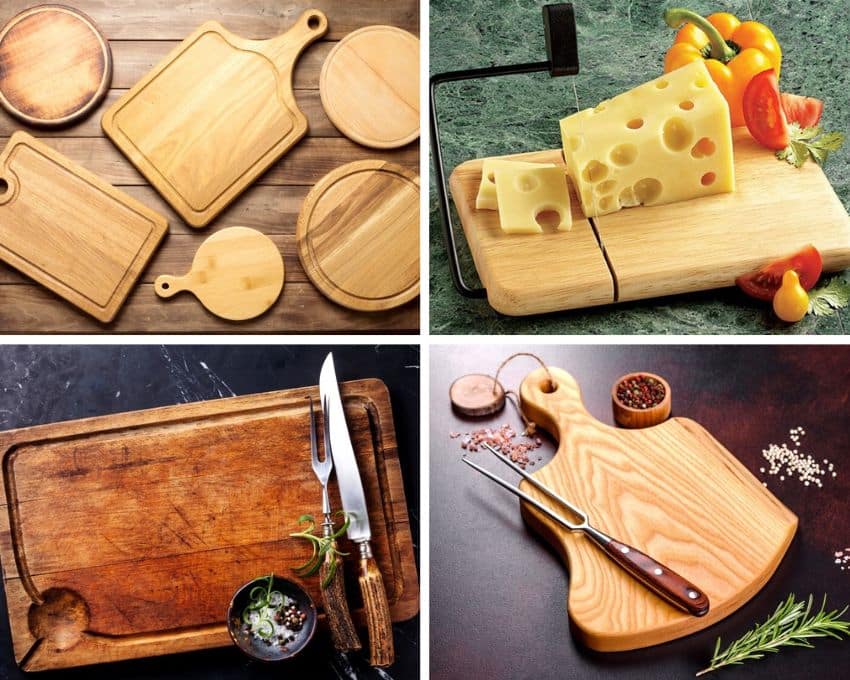
One of the most common ones would be the all-purpose cutting board. This board is so versatile that it can be used anywhere from cutting up vegetables to slicing bread, and so many other uses in the kitchen as well as in the dining room.
A cutting board can be made out of different materials and can come in a lot of different shapes and sizes. The more nitpicky homeowner or even a professional kitchen would use color-coded cutting boards to avoid cross-contamination in the food that’s being prepared.
A typical cutting board in the kitchen would be about an inch thick and should have enough weight for you to chop things without it moving around on your kitchen countertop.
Butcher Block
The butcher block differs from cutting boards in terms of thickness and weight. It’s considerably thicker and heavier. Butcher blocks are typically used for de-boning and chopping meat, so it has to be thick and heavy enough for you not to worry about food slipping off of the counter when you’re cutting them up.
The larger the butcher block, the less likely it is for your food to slip off while you’re working on it. This minimizes the risks of injury as well as limits the spread of bacteria and germs on the food materials being chopped up.
Carving Board
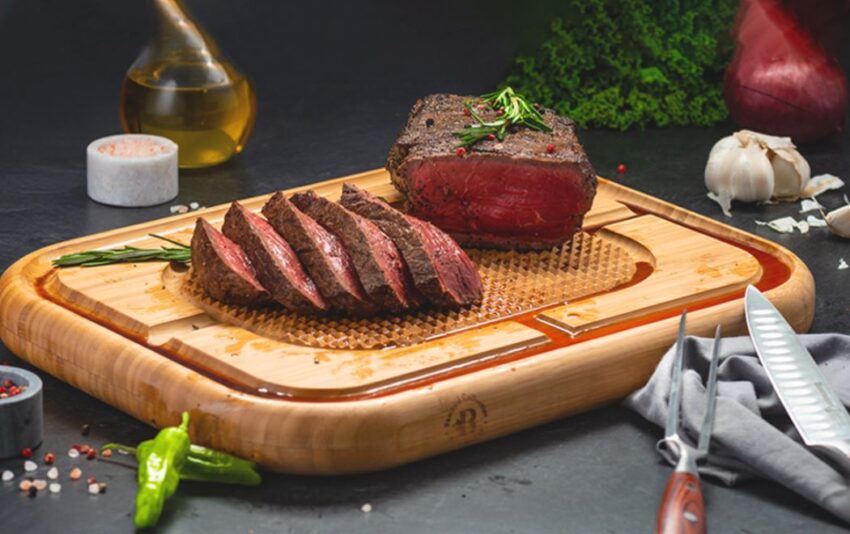
A carving board is just like a regular cutting board, but it has the unique feature of having juice through lines depressed within the board itself. This is designed for the safe cutting of meats and juicy or watery fruits and vegetables that might make a mess all over your kitchen countertops.
The juice trough makes cleanup easier and keeps the juices in for easy disposal on the kitchen sink after the food has been cut up.
Bread Board
If you’re the type who enjoys good sliced bread and is quite particular about having it cut the right way, then you should definitely invest in a breadboard.
As opposed to the regular kitchen cutting board, breadboards are usually much longer, designed for them to handle the length of different loaves of slices of bread and baguettes and the like.
They also do a great job of keeping the crumbs together so that you don’t have a huge mess to clean up right after.
Flexible Cutting Mat
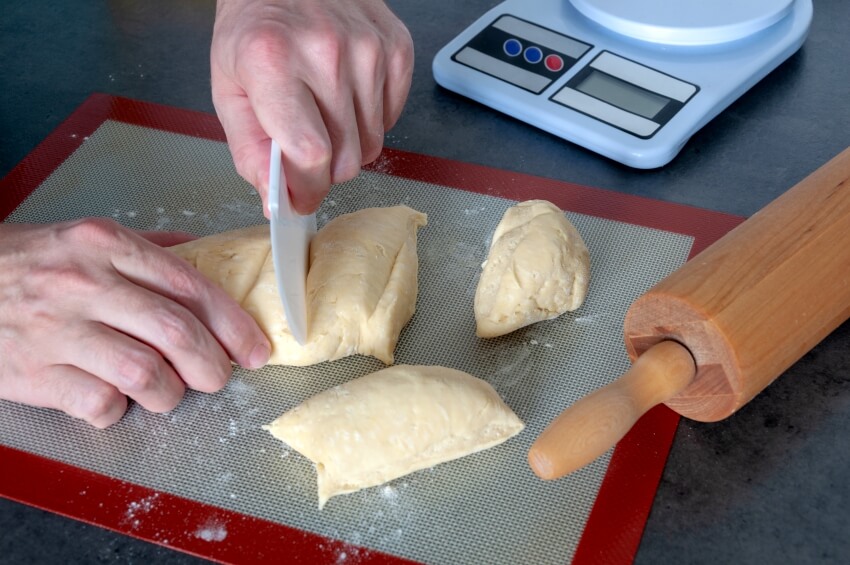
With a flexible cutting board, you can fold it up and create a funnel to dump your chopped-up food ingredients into a pot, work, or whatever cooking implement you may be thinking about using.
A flexible cutting mat is something that you can bend and twist into any shape you may want or need, so you don’t have to worry about scraping or picking up the food and possibly spilling it, minimizing wastage.
Materials
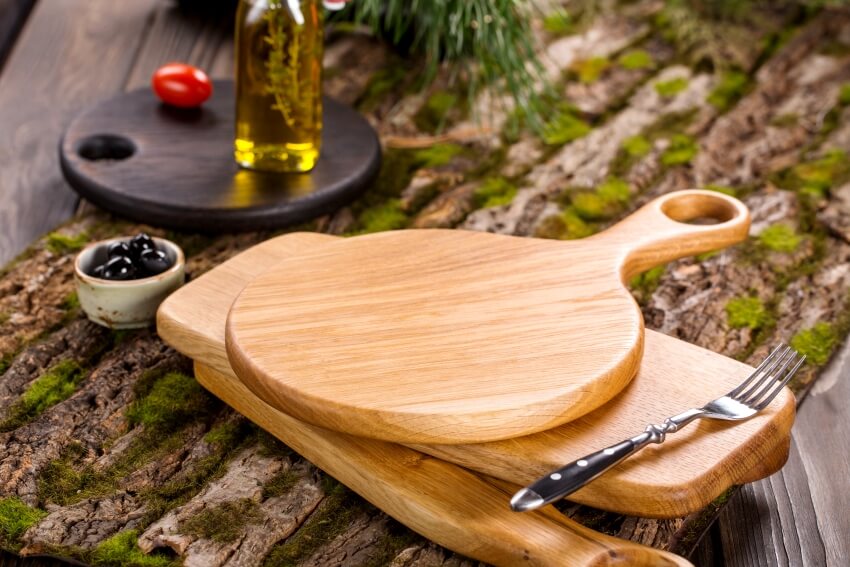
Before we get started, here are a few things to tick off of your list when you’re in the process of looking for a great cutting board to purchase:
It has to be knife-friendly. Harder surfaces can dull your knives over time so keep that in mind.
It has to offer easy cleanup. Consider options that are dishwasher friendly or those that can be scrubbed down without getting damaged.
It is easy to maintain. Is it wash and go or is it the type that requires periodic maintenance and conditioning with substances such as board oils?
Long-lasting and durable – It has to last long enough so you don’t have to constantly replace it.
Other factors to consider that may or may not be important depending on your needs are:
Budget-friendly – It has to be friendly to your set budget.
Compact design – It has to fit in well with the amount of countertop space you have in order for you to work efficiently without space constraints or whatsoever.
Wood
Wood cutting boards are great. With the proper amount of care, they’re quite safe to use, are gentle enough on your knives, and will last you for a very long time.
What’s great about wood boards is that they come in a wide range of prices that can be anywhere from $20 or all the way up to $200. It all boils down to what your preferential choices are, really. There are also lower-priced versions in wood laminate.
They come in 2 categories: hardwoods and softwoods. Here are the differences between the two:
Hardwoods

Smaller pored woods block bacteria from getting into the surface of the board. It makes it quite difficult for knives to create cut grooves where the bacteria can dwell on. Wood also has tannins which act as natural antimicrobials.
Softwoods
Softwoods aren’t the first choice for cutting board materials because they’re more porous than hardwoods and can encourage bacterial growth.
However, the few softwoods that work, such as hinoki and larch wood, are sometimes manufactured as cutting boards but with the use of end grain construction for durability.
How to care for your wood cutting boards: Don’t run them through a dishwasher. This can ruin them as the high heat can cause the wood to split and possibly cause them to warp in the long run.
Bamboo
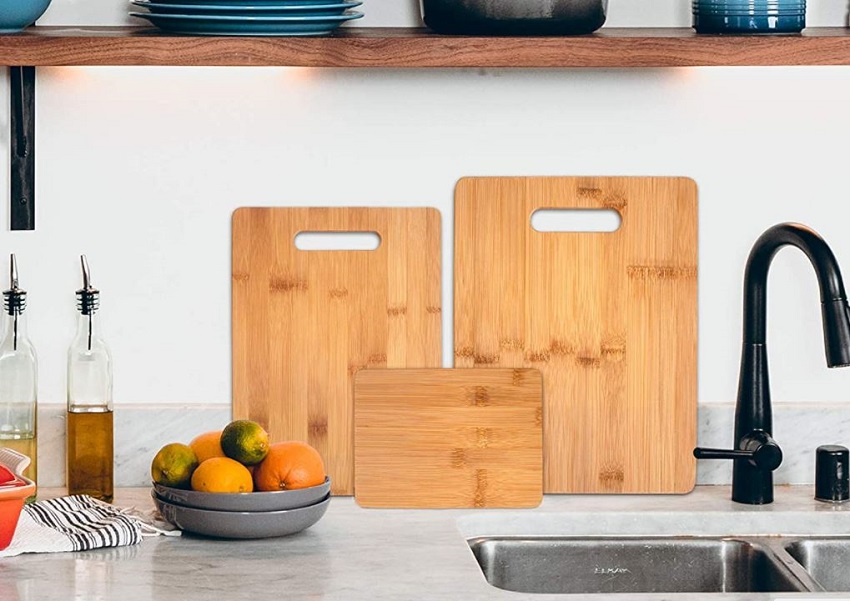
Bamboo cutting boards are inexpensive as the main material is a common grass classification. They’re far more sustainable compared to wood, and they can be pretty lightweight. If cared for the right way, they can be quite durable and will last you for a very long time.
A decent bamboo cutting board can range anywhere from $10 to $150 for heavy-duty ones. They come in end grain and edge grain styles, with the edge grain style being more expensive.
Bamboo is also known to be harder than wood, so they are known to dull your knives faster than their wooden counterparts. Still, they can be a great budget-friendly choice with the added bonus of being sustainably sourced.
How to care for your bamboo cutting board: Don’t put your bamboo cutting board in the dishwasher, and it works best if you periodically condition it with some board oil.
Plastic
Plastic cutting boards are all the rage right now, and they can come in a wide variety of colours and sizes as well as different styles. However, they’re not the most durable options out there, so don’t expect them to last for very long. They are quite affordable, though, and they don’t cause your knives to get dull.
If you take care of them the right way, they won’t warp or crack. Plastic can go from budget-friendly ones to high-end commercial-grade ones and can range anywhere from under $10 to all the way up to $100.
A major downside to getting plastic cutting boards is that the cut marks will stay there forever. As opposed to wooden boards, which can self-heal as the fibers close back up over time, plastic cutting boards will stay marked with cut marks once they’re made, and they’re bound to stay that way. This makes plastic boards unsafe to be kept for a long time as the grooves can be a home for bacteria.
Also, not all plastics are made the same way. When in the market for a plastic cutting board, it would be best to keep an eye out for plastics that are labeled as HDPE or high-density polyethylene as opposed to the usual standard polyethylene or PE. It’s more durable and is bound to last much longer.
Epoxy Resin
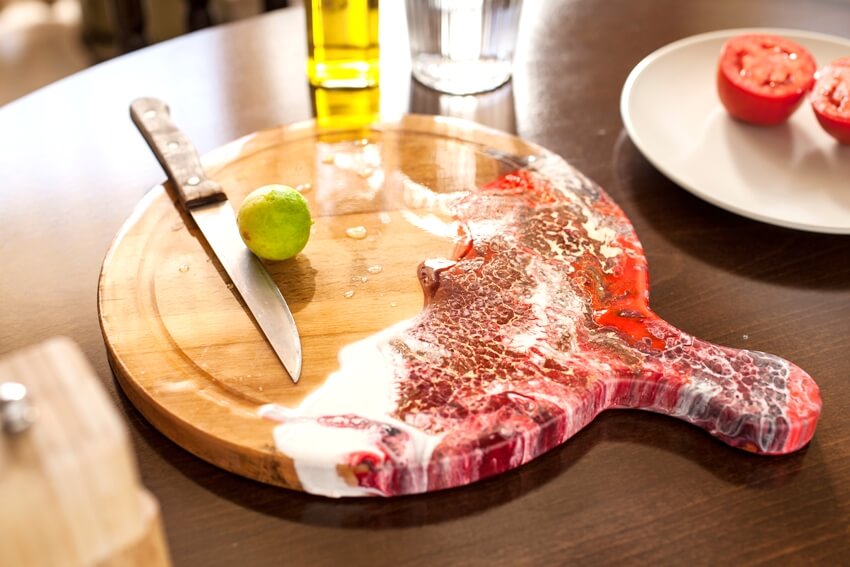
Food-grade epoxy resin cutting boards are all the rage right now because, for the most part, they are artisanal. There are so many shapes, designs, and colors out there that the only limit would be the artist’s imagination.
As a cutting board in general, the best option is to just say no. The safest type of epoxy resin out there is food grade, not food safe. Epoxy can be safe for purposes not related to cutting, such as using it as a bread or charcuterie board.
Epoxy resin, like plastic, does not self-heal. This means that deep scratches and cuts could be susceptible to bacterial growth in the long run, plus the added risk of chemicals in the epoxy resin getting into the food that’s being cut. Still, it makes for very aesthetic boards and should be safe enough to put food on it, just not cut on its surface.
More cost-effective variants are made out of acrylic, high-pressure laminate, polypropylene, or even nylon.
Granite
Granite cutting boards are absolutely beautiful. They, however, have very hard surfaces, which means that they can make your knives dull very quickly. They’re better used for purposes that don’t involve cutting, such as rolling the dough out, instead of chopping food items on their surfaces.
Granite cutting boards can be very expensive and don’t usually come top of mind as they can be impractical that way. If you do, however, happen to be fortunate enough to buy one; make sure that you constantly sharpen your knives.
You may also use granite cutting boards as trivets for when you have hot pans and dishes that you don’t want to go in direct contact with your countertops.
Marble
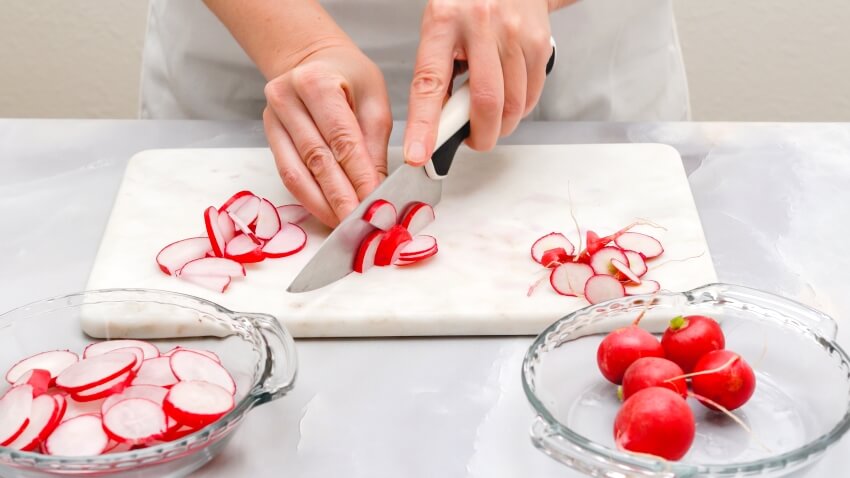
Similar to granite, marble boards are incredibly gorgeous, but with the same downside as granite they can also dull your knives or even damage them permanently.
Marble cutting boards are best used for displaying cheese trays and charcuterie, as a trivet, or just as an elevated platform for a main dish on the table. You can still enjoy them. Just make sure not to use them for cutting.
Stoneware
Stoneware cutting boards are quite brittle and have hard surfaces, which is why their main purposes shouldn’t be for chopping or cutting at all. This can dull your knives or get them damaged.
They are attractive to display food on though or as a trivet as well. If you insist on chopping food on a stoneware cutting board, just be aware enough to sharpen your knives more often and to be a little gentler for when the knife comes in contact with its hard surface.
Other variants can come in soapstone, slate, or even ceramic.
Silicone Rubber
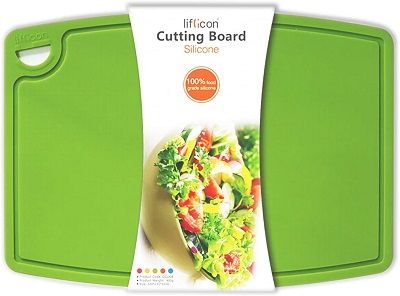
Silicone rubber cutting boards are best if you have particularly expensive knives that you don’t necessarily want to get dull so quickly. It provides a surface area that’s cushioned and designed to protect the edge of the knife, so you don’t have to be inconvenienced with regularly sharpening it.
It is also flexible, so you can bend it, twist it, and easily transfer the cut-up food from the cutting board to a pot or for disposal. Since silicone isn’t a porous material, it also means that it can effectively resist bacterial growth.
Silicone cutting boards are also non-slip, which means that you can safely cut up your food without ever running the risk of having it slip off of the countertop and possibly hurt your hand.
Glass
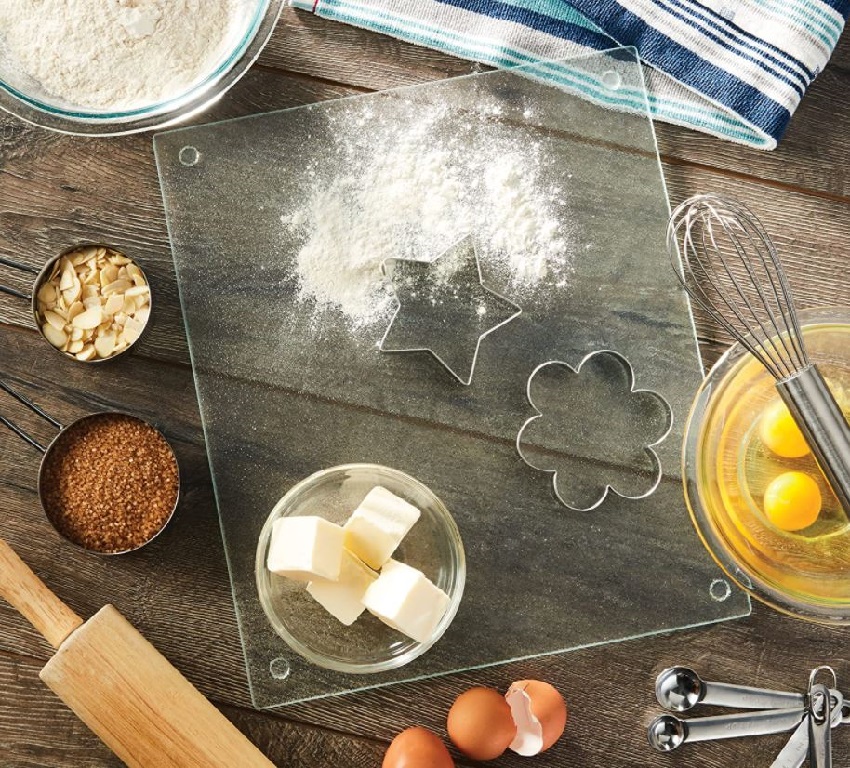
Tempered glass cutting boards look very appealing and sleek, but because the surfaces are hard, you’re bound to run across the same issues with marble and stoneware cutting boards.
Knives just won’t be able to last long with tempered glass cutting boards. They also often have textured surfaces, which means that they can harbor bacteria that can end up contaminating your food.
Wood Edges
Interestingly, wood cutting boards come in all sorts of edges. They’re all interesting, and they each have their distinct traits to highly consider before you make your decision:
Live Edge Board
For starters, the name is interesting. Live edge cutting boards got this name because their edge comes from the unprocessed and organic shape of the tree that it was cut from.
They’re made out of a solid hardwood piece, treated accordingly so that they’re food safe, and although they have typical shapes and dimensions, their actual finished pieces may vary as no single tree is completely alike. This type of cutting board is very resistant to getting split or cracked.
Edge Grain Board

Edge grain cutting boards are composed of strips of wood that have been grafted together while arranged side by side.
Different strips of hardwood made up of different types of wood can be showcased through edge grain cutting boards. They usually have a striped appearance from the uneven colors of the woods used.
They are visually beautiful and have all of the benefits of a wooden cutting board. The only downside is that they can show deep scratches and cuts faster than the end grain cutting boards. However, when washed and scrubbed, and dried properly, they can stay sanitary and last longer.
End Grain Board
An end grain cutting board, on the other hand, is comprised of many pieces of shortly cut wood that have been grafted while arranged vertically. The ends of these short pieces of wood are showing on the surface, which explains its name.
They’re known to be long-lasting and are quite known to not show knife marks that easily, which means they won’t get your knives dull, unlike plastic, glass, stone boards, and the like. They are, however, priced higher as they are more labor-intensive to produce.
Features
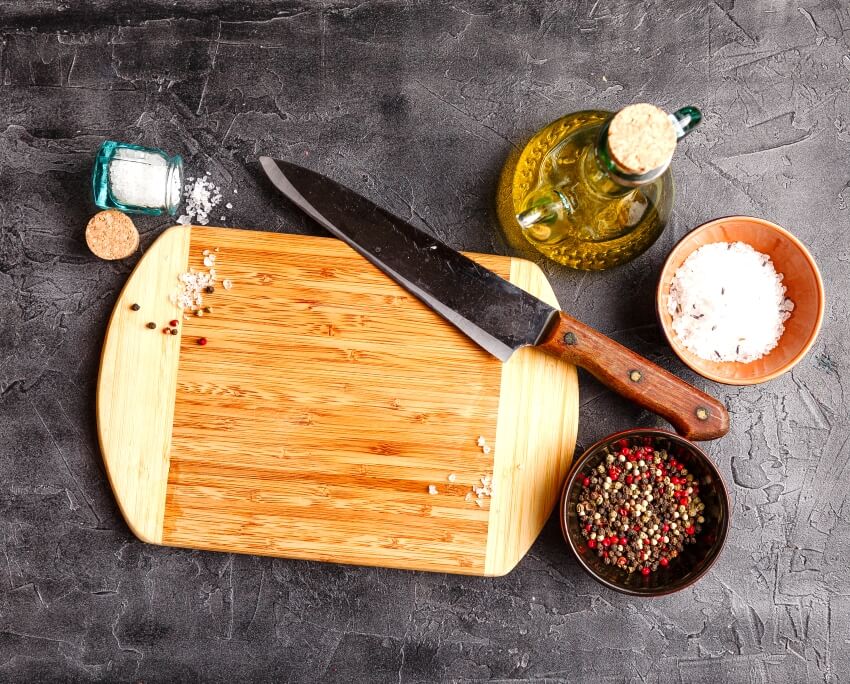
If you’ve read far enough, you probably appreciate by now how intricate cutting boards can be, and you probably see them differently now from when you first started reading this article. Cutting boards also have a lot of different features. They go far beyond just the design, type, material that it’s made of, thickness, and so on.
Cutting boards these days have evolved so much that if you don’t keep yourself updated about them, you’re going to miss out on some life-changing innovations. Here are some that are worthwhile enough for you to check out:
Non-Slip
Obviously, any place wherein there are knives involved could easily turn into a dangerous place, and the kitchen comes front and center when it comes to that. A non-slip feature should be the first thing on your list when you’re out shopping for a cutting board.
It lessens the possibility of accidental food spillage or, worse, accidents caused by your board slipping from the countertop. Some people would put a rubber mat under their cutting boards or even a damp towel.
But why go through all of that trouble when you can just buy a non-slip mat from the get-go and never have to worry about it again?
Grooved

Raw food, in general, has the tendency to get wet. It can be vegetables, meats, or fish. The common denominator is that they secret fluids or some type of moisture when they get chopped up. This is where the grooves in the cutting board come in handy.
They serve as troughs for these juices so that your food never has to sit in its own fluids. It’s also quite hygienic as it contains the liquids in the board instead of spilling them all over the countertop, contaminating all of the surfaces that they can come across.
Dishwasher Safe
Cutting boards are very prone to knives or cut scars, and when not cleaned properly, this can harbor bacteria. However, these scars on the cutting boards can be very difficult to clean by hand. So when looking into buying a brand new cutting board, always try to figure out if it is dishwasher safe.
Putting a cutting board in the dishwasher is one of the fastest and most effective ways to get it cleaned. Hot water will definitely get rid of the bacteria, even if your cutting board may have deep knife scars on the surface.
With Handle
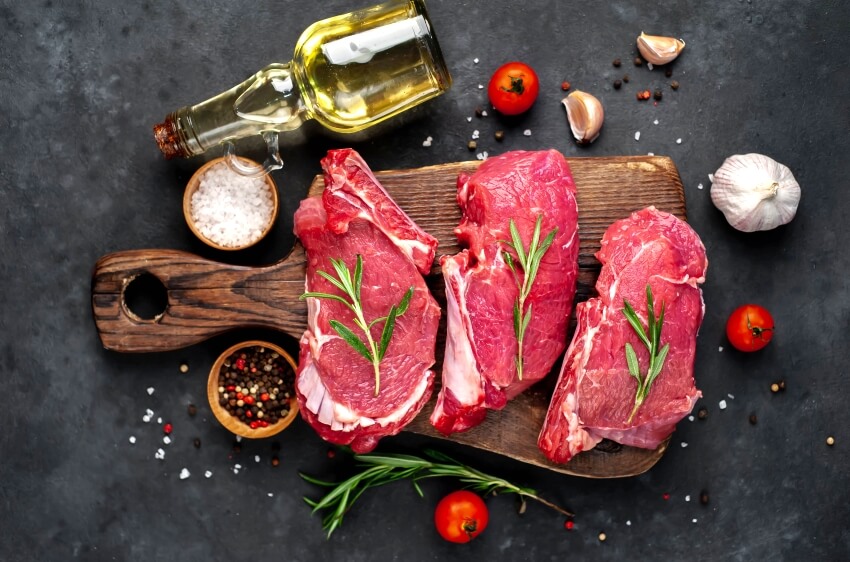
Although cutting boards with hole handles initially makes us think that it’s for holding them up, that’s actually not always true.
In some models, the hole-in handles can also be there for putting the cut-up food through it so that you never have to spill the ingredients anywhere else but the pot or plate or wherever you would like them to be. It’s a great cutting board feature if you like keeping it clean as you go.
With Knife
Some thematic cutting boards come with knives that have handles that match their décor. It’s a great feature to have if you’re particular about mixing and matching your kitchen up and always making sure that the design elements are cohesive for the rest of the kitchen. See our gallery of stunning gourmet kitchen design ideas here.
With Cheese Cutter
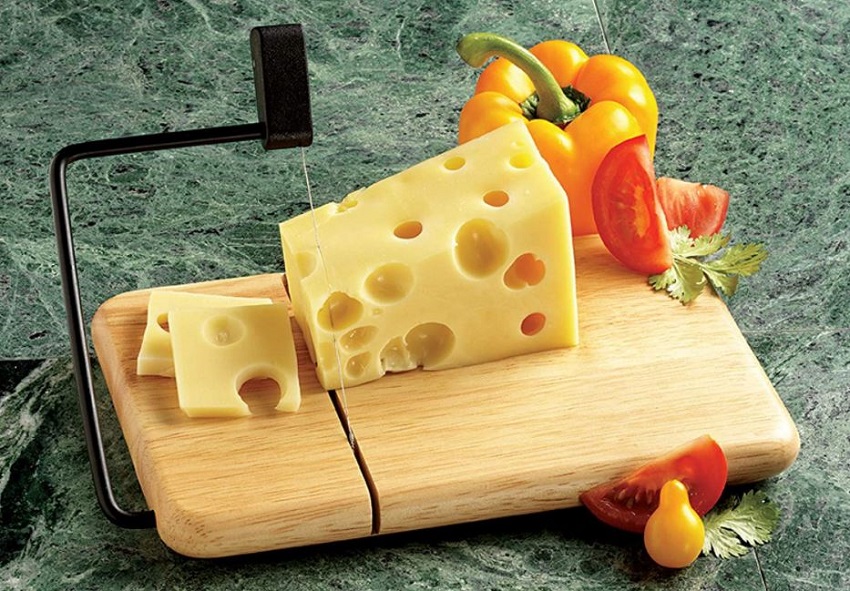
A cutting board with a cheese cutter will make it totally versatile. Not only will the cutting board be able to function as a regular cutting board, but it can also function efficiently as a cheese cutter when armed with one.
Over The Sink Board
Over-the-sink cutting boards are great for optimizing your small kitchen without ever spending any extra money on renovations or extensions.
True to its name, this cutting board was specifically designed to be put on top of a sink, bringing your space-saving endeavors in the kitchen to a whole new level. Read more about how to organize a small kitchen here.
Over The Edge Board
Over-the-edge cutting boards are great because they completely eliminate the possibility of you having to deal with the board sliding over the countertop or just getting slippery ever again.
It got its name from its main feature, wherein an edge lip ensures that the cutting board is locked to the edge of the counter. This means that the cutting board doesn’t move, no matter how heavy the chopping or kneading may be.
Color Coded Boards
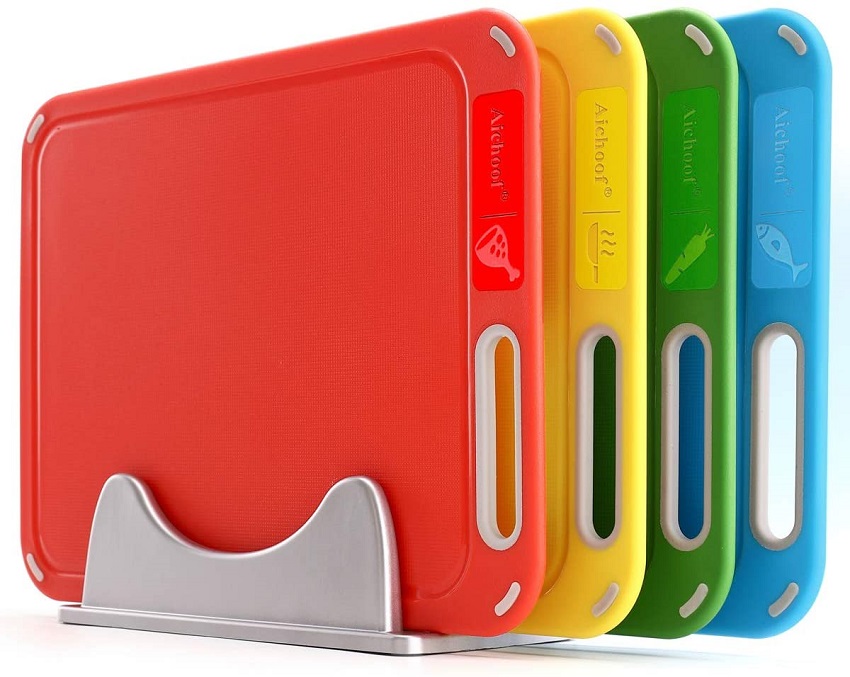
Color coding for cutting boards was first introduced by HACCP or the Hazard Analysis Critical Control Point. This system manages food safety, particularly for the Hospitality industry and all the businesses tied to it. A lot of certified foodservice establishments observe this colour chopping board identification.
Cross contamination or food poisoning is common in the hospitality industry. This is mainly caused by transferring bacteria from one food to another through hands, contaminated tools, and other related equipment.
Cutting boards are prime culprits for these things, so it was established to color code them, separating them into different food groups, to help eliminate cross contamination risks.
Although this might not be a risk in your home, some homeowners like to observe HACCP standards for having different cutting boards for different food items.
Each cutting board color signifies a special use for it and ingredients that should be chopped on it. Another version of this is plastic laminates or fiberglass cutting boards.
Colour Coded Chopping Boards Meaning
- Green: Fruits and vegetables
- Yellow: Poultry
- Brown: Cooked food
- White: Dairy
- Blue: Seafood
- Red: Raw meat
Set Of Different Sizes
Cutting boards come in 3 standard sizes: standard, small, and large. Here’s how they differ from each other:

Standard: They’re usually sized at varying measurements but the most common are 12 X 18 inches, 10 X 14 inches, and 15 X 20 inches.
They’re considered as the standard size because they’re big enough for you to cut up multiple food items on it but still small enough for it to be convenient for storage.
Small: They’re very easy to store and they come in the common measurements of 4 X 6 inches, 5 X 7 inches, 6 X 9 inches, and 10 X 8 inches.
They’re great for when you’re cutting up single serve snacks and other fruits as well as for mincing herbs for cooking. They’re not, however, suitable for cutting up meats and other bigger sized food items in the kitchen.
Large: Large cutting boards are a bit difficult to store and move around with. They come in measurements of 7 X 23 inches, 18 X 18 inches, 18 X 24 inches, 18 X 30 inches, and 20 X 30 inches.
Despite the obvious disadvantages of their size, large cutting boards are great for when you’re trying to chop up multiple items all at once, which is why they can be a favorite in commercial kitchens. In a home kitchen, they can easily be the pièce de résistance.
Customized
Obviously, you can customize any cutting board of your choice to any shape or size that you want, but there are just a few basics to keep in mind while you’re at it.
Go for something that’s easy on your knives. Wood, composites, and plastics should work best.
Get a large enough cutting board. Not having enough space to cut up your food can be a hassle, and although you might want to save space as an afterthought, your kitchen experience should always come first.
So for as long as the board fits on your countertop, go for the biggest size that you can get. 12 X 18 inches is always a great place to start unless it is impossible to work into your space.
Go for something that’s easy to sanitize and clean. Some plastic boards can be dishwasher friendly, but over time, they have the tendency to absorb smells.
Wooden boards require a little more attention for their maintenance, but with the proper care, they can last for quite a long time.
Recipe Board
A recipe cutting board isn’t exactly a cutting board but more of a decorative element that you can have in your kitchen. This is great if you have family recipes that have been handed down from one generation to the next that you want to kind of commemorate as a kitchen décor.
The recipe is usually written down on a wooden cutting board with any material from paint to special pens or even via engravings, depending on what you prefer.
Board Shapes
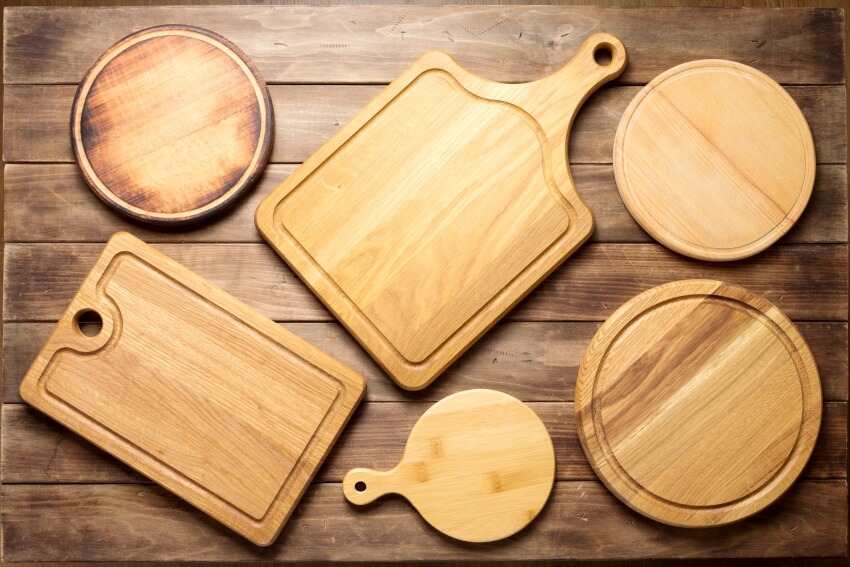
Basically, cutting boards can come in different shapes and sizes, and when considering them, it would be smart to consider the amount of countertop space you have to work with.
Obviously, larger countertops allow you the luxury of having a much larger area to work on, and it also means that you can get bigger-sized cutting boards by extensions.
Rectangle
This is the most popular shape for a cutting board. Rectangular boards are great for when you’re chopping up multiple food items because you can kind of scrape the food over to a certain area in the board to make space for you to chop other items up.
Rectangle boards are practical to have, and most of them come with rounded corners so that you don’t have to worry about getting your hand hurt in case you knock it over one of the corners while you’re cutting.
Square
Square cutting boards are not easy to work with. They aren’t long enough to give you enough room for slicing and chopping food items on them, and they also feel cramped and just short on space overall.
Needless to say, square cutting boards are inadequately shaped to actually be conducive to a good kitchen workflow. It’s more recommended for plating and other decorative uses.
Round
Round cutting boards are, no doubt about it, very attractive. However, in terms of function, they don’t really offer much. This is why round-shaped cutting boards are commonly used to display food on the table.
Should you insist on using a round cutting board for food prep, make sure that it’s large enough for you not to end up injuring yourself.
Semi-Circle
If you like the aesthetics of a round cutting board but hate it being unsafe or suitable for chopping and slicing, then a semi-circle just might work well for you.
The flat side of this cutting board can be pushed up against the wall, allowing you to anchor the cutting board while you work on the food items that you need to cut up without the risk of having the cutting board slip or you injuring yourself.
Best Type Of Wood For Chopping Board
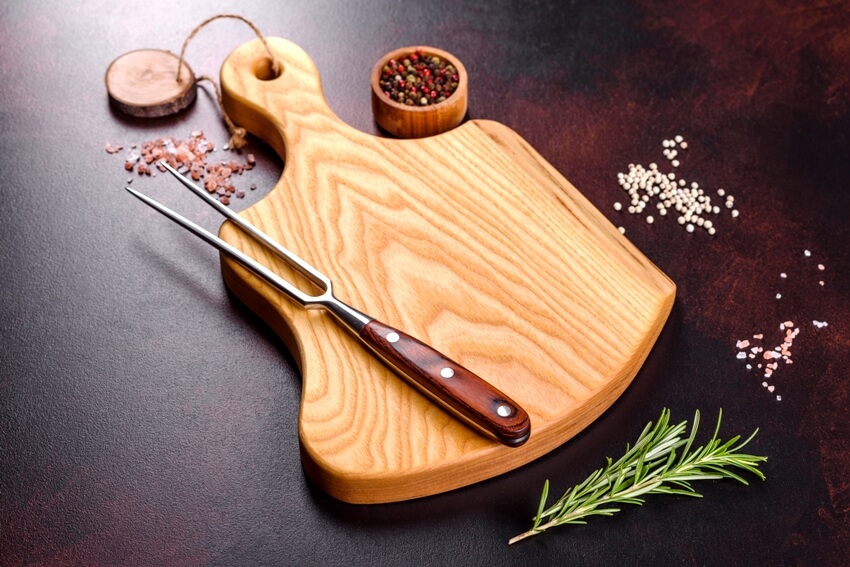
Maple has just the right amount of hardness to make it durable enough to last long and for it not to scar too much from its exposure to knives, lessening its risks of harboring bacteria.
Wood, bamboo, and plastic boards are kinder to knife blades, while tempered glass and metal cutting surfaces can cause premature dulling. – Jeffrey Elliot and James P. DeWan, The Complete Book of Knife Skills: The Essential Guide to Use, Techniques & Care
Best Board Material
Rubber. It’s perfect for all sorts of kitchen ingredients, whether you do a lot of baking, chopping up vegetables, raw meat, and so on. Rubber is the common choice for professional kitchens mainly because it isn’t porous, so bacteria won’t exactly be able to penetrate through its surface.
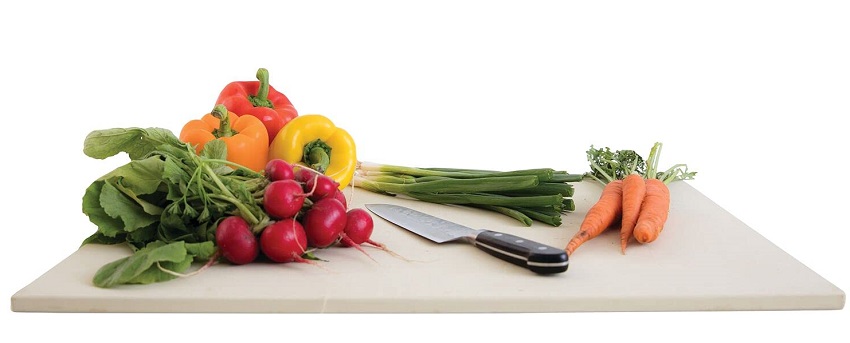
It’s also a material that’s more scratch resistant than plastic. So it’s soft enough for you to cut on while at the same time, it protects the quality and sharpness of your knives, especially the expensive ones, making them last even longer.
What Is The Most Sanitary Type Of Chopping Board
Again, it would have to be rubber. One of the major downsides for most cutting board materials, from wood, to plastic and so on, is that the knife marks will eventually deepen and run the risk of harboring bacteria, which can lead to food cross-contamination.
This is not the case with rubber, as rubber can eventually be sanded down and resurfaced in the event that they have deep knife marks and scars.
Wooden cutting boards should be washed with warm soapy water and rinsed well, while plastic and rubber cutting boards can be washed in a dishwasher. – The Culinary Institute of America (2011), The Professional Chef
They are dishwasher safe and pretty heavy duty and easy to clean as well, making rubber cutting boards one of the most sanitary cutting boards to get your hands on. [Source: fsis.usda.gov Cutting Boards]
What Type Is Best For Meat
Plastic is the best cutting board material to be used for slicing meat, especially raw meat. This is because plastic has a non-porous surface and is typically safe to run through the dishwasher.
This makes cleanup a breeze, making it easy to sanitize the board after every single use. Plastic cutting boards don’t absorb juices as opposed to wooden boards.
What Is The Safest
Hardwood cutting boards are the safest. They’re fine-grained, making them naturally resistant to bacteria, and it’s been said that wood has capillary actions that pull fluids down, trapping the bacteria, to eventually kill it off as the board dries once it’s been cleaned. They’re also heavy enough to not slip and minimize injuries in the kitchen.
What Type Of Wood For End Grain Board
End grain cutting boards are usually made out of hard maple, walnut, birch, oak, or cherry. It’s been recommended that the best way to process them would be to have them cut up in either 2.5 or 3.5 inches thick so that they don’t easily warp or split.
Best Board For Knives
According to a general consensus among knife experts, chefs, food hygienists, and kitchen fanatics in general based on usability, chopping experience, safety, and sanitation, wooden chopping boards are the best for knives.
End grain wooden chopping boards, in particular, offer just the right amount of hardness to not dull the knives, taking better care of them. This is particularly important to have for expensive knives.
Bamboo Vs Wood
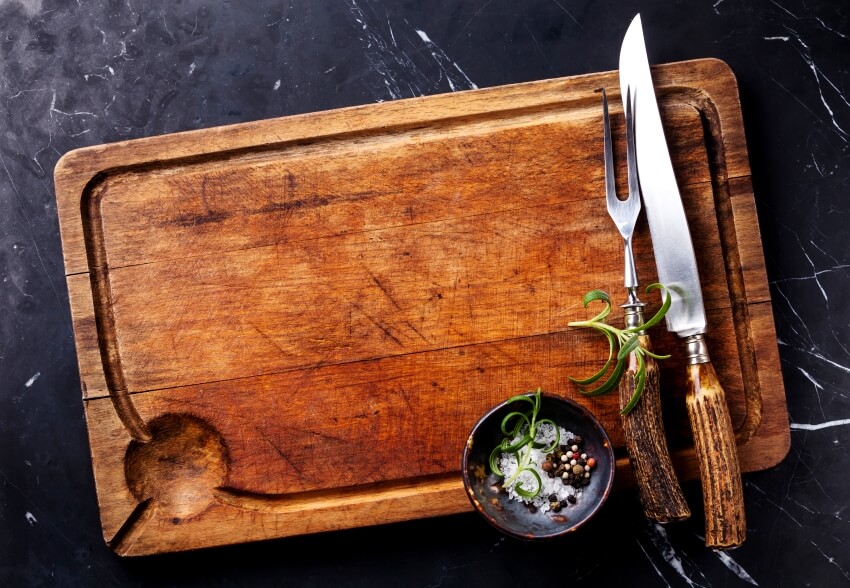
The main difference between a bamboo and wood cutting board is the hardness. Bamboo, although categorized as grass, is known to have a much harder surface compared to wood. This means that bamboo is far more resistant to moisture and germs, and other bacteria growing on its surface compared to wood.
The downside to this, though, is because of the hardness of its surface, it also means that it can dull your knives faster.
So in the essence of the overall experience, sustainability, and knife maintenance, wood would still be the more sensible choice, especially if you happen to have expensive knives in the kitchen.
How To Clean
When cleaning a cutting board, it’s best to keep it nice and simple. You only need the basics: some hot water, dish soap, a sponge with a gentle abrasive, and a place to let it stand and air dry.
Make sure that both sides of the cutting board are washed before using it again, even if you only initially used one side.
Over time, a cutting board might have deep knife scars. Make sure that the surface is sanded down so that you can get rid of the deep grooves on the surface, making it less prone to bacteria and germ growth.
What Type Of Mineral Oil For Maintenance
Pure food-grade mineral oil is the best substance to use for cutting board maintenance. It’s very affordable at only around under a dollar per ounce. It has no odor, taste, or color, and it’s particularly resistant to oxidation.
Oxidation is common to most oils. This is when the oils become rancid when exposed to oxygen and other elements such as light, moisture, heat, and so on.
Check out our guide to essential small kitchen appliances to see more useful kitchen products.


